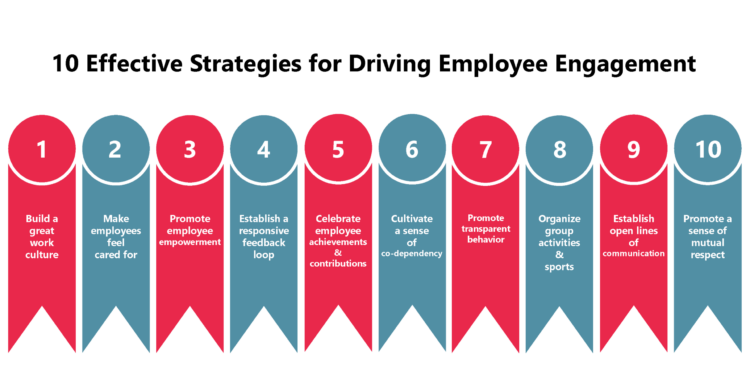Create a positive work environment: Build an excellent work culture where employees feel valued, cared for, and respected, promoting mutual respect and open communication.
Empower and recognize employees: Promote employee empowerment by granting autonomy and recognizing achievements, contributions, and personal milestones to boost motivation and engagement.
Establish effective communication and feedback: Maintain open lines of communication and implement a responsive feedback loop to foster trust, transparency, and a sense of belonging among employees.
Encourage collaboration and team activities: Organize group activities and cultivate a sense of co-dependency to strengthen teamwork and interpersonal relationships and enhance overall engagement.
Employees’ feelings about their work and workplace can contribute significantly to organizational success. Here are ten practical strategies for driving employee engagement that organizations can implement to enhance business success:
1. Build an excellent work culture
2. Make them feel cared for
3. Promote employee empowerment
4. Establish a responsive feedback loop
5. Celebrate employee achievements and contributions
6. Cultivate a sense of co-dependency
7. Promote transparent behavior
8. Organize group activities and sports
9. Establish open lines of communication
10. Promote a sense of mutual respect


Work culture impacts engagement significantly, which is why organizations need to work towards building a great one.
Employees love to be in an organization where there is fun at work and the overall ambiance is inclusive and supportive.
Such a work culture makes employees feel valued and more willing to contribute to business growth and success.
Building a great work culture is one of the most effective strategies for driving employee engagement.

When employees feel that their employers care for them as individuals, their engagement level increases naturally.
A simple inquiry about the employee’s welfare by the manager or even a day off without asking too many questions during a family emergency is an effective way to show care.
Finding out what matters the most to each employee professionally and personally can go a long way in driving engagement.

Making employees feel empowered fills them with a sense of ownership due to their employer’s faith in their abilities.
Empowerment can happen by giving employees the autonomy to complete tasks assigned to them in their own way.
Allowing employees to take responsibility for their work and handle new challenges ensures their development through experiential learning.

Providing and receiving regular feedback is paramount for improving employees’ engagement levels.
Providing effective feedback makes employees aware of their strengths and shortcomings.
Similarly, giving feedback allows one to express one’s views and opinions about various business processes and management aspects.
This two-way setup is essential to strengthen the sense of belonging and enhance employee motivation.

Employees appreciate recognition for their contributions to business growth and achievements.
That is why celebrating the achievements and contributions of the employees proves extremely effective in driving engagement.
It assures employees that their efforts, commitment, and performance are valued.

Employees should be aware of the importance and benefits of working in close coordination with their peers and coworkers.
Hence, by cultivating a sense of supporting the efforts and initiatives of their fellow workers, organizations can build a positive work culture based on trust.
Therefore, it helps to improve inter-personal interaction and minimize any chances of misunderstanding between employees to create a truly engaged workforce.

Ensuring greater transparency in business processes and policies is the key to employee happiness and satisfaction.
Hence, trusting employees with critical information and involving them in decision-making removes the “us versus them” tussle in employee-management relationships.
Most importantly, it cultivates the feeling of being integral to the organization and significantly promotes employee productivity and engagement.

Group activities such as sports provide opportunities for employees to interact with their coworkers and superiors informally.
To maximize the effectiveness of these activities, it is essential to ensure the active participation of the management.
Moreover, it is essential to plan the activities considering the diverse preferences and likings of different groups of employees.

The employees must be able to communicate with their superiors in an open and frank manner.
They must educate their managers to make it easy for employees to discuss professional and personal issues.
In addition to helping build trust, such communication also promotes greater engagement.

One of the key reasons that makes employees feel disengaged is the lack of respect towards them.
It is also one of the major causes of low employee retention in organizations.
Hence, organizations need to work towards developing a sense of mutual respect among employees irrespective of their hierarchical position within the organization.
Implementing the above strategies for driving employee engagement significantly. However, organizations should adopt a patient approach and constantly make improvements to the strategies based on the results.

Lead author: Sagar Chaudhuri, the Co-Founder and CEO of HiFives. He is an HR Tech Evangelist with over 25 years of corporate and entrepreneurship experience. In the past, Sagar has worked in leadership roles at companies such as Genpact, Infosys, and ICICI Bank. He has an engineering degree from IIT Kharagpur and an MBA from IIM Lucknow. Connect on LinkedIn
To stay updated on the latest HiFives blogs, follow us on Twitter (@MyHiFives) and learn more about HR Best Practices on HiFives.